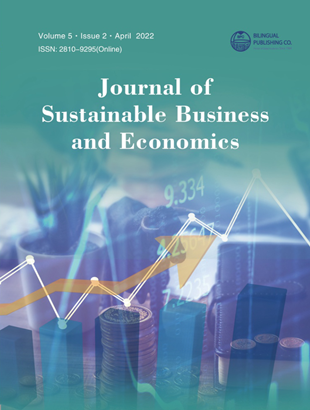-
255
-
176
-
158
-
128
-
125
Sensitivity of Crude Oil Price Change to Major Global Factors and to Russian–Ukraine War Crisis
DOI:
https://doi.org/10.30564/jsbe.v5i2.10Abstract
To assess the elasticity of crude oil price to global factors related to supply of crude oil and the US dollar exchange rate, the authors employed nonlinear models including flexible least squares, and maximum likelihood estimator, in addition to OLS regression mode; using yearly data from 1965 to 2021. The findings indicate change in oil prices due to 1% change in any of the explanatory variables, as follows: the effect of the US dollar depreciation rate, raise crude oil price/barrel by 71 US cents; and increase in OPEC production, decrease crude oil price by 82 US cents; a decrease in non-OPEC production, raise oil price by 4.78 US$. These results imply that, if a ban imposed on Russian crude oil export, and no increase in OPEC production to compensate Russian oil loss in the international markets, global crude oil price expected to rise by 88 US$ above its level before Russian–Ukraine crisis, meaning that crude oil price expected to rise at 160 US$ pbab. However, if OPEC members increase their output level by 10 million barrels per day to compensate the Russian oil loss, then global crude oil price is expected to stay at 102 US$ pb.
Keywords:
OPEC; Crude oil price; Russian and Ukraine crisisReferences
[1] Kilian, L., 2009. Not All Oil Price Shocks Are Alike: Disentangling Demand and Supply Shocks in the Crude Oil Market. American Economic Review. 99(3), 1053-1069.
[2] Wang, S., Chen, Y., Jin, Y., 2009. Analysis of the impacts of emergencies on international oil prices. Mathematics in Practice and Theory. 9, 88.
[3] Coleman, L., 2011. Explaining crude oil prices using fundamental measures. Energy Policy. 40(C), 318- 324.
[4] Fang, Ch.R., You, Sh.Y., 2014. The impact of oil price shocks on the large emerging countries’ stock prices: Evidence from China, India and Russia. International Review of Economics & Finance, Elsevier. 29(C), 330-338.
[5] Ji, Q., Guo, J.F., 2015. Oil price volatility and oil-related events: An Internet concern study perspective. Applied Energy. 137(C), 256-264.
[6] Liao, S., Wang, F., Wu, T., et al., 2016. Crude oil price decision under considering emergeny and release of strategic petroleum reserves. Energy. 102, 436-443.
[7] MacAvoy, P., 1982. Crude oil price as determined by OPEC and market fundamentals. Publisher: Ballinger.
[8] Amano, R., Van Norden, S., 1993. Oil prices and the rise and fall of the U.S., Real Exchange Rate. working papers, Bank of Canada. 93(15).
[9] Kaufmann, R., Dees, S., Karadeloglou, P., et al., 2004. Does OPEC matter? An econometric analysis of oil prices. The Energy Journal. 25(4), 67-90.
[10] Dees, S., Karadeloglou, P., Kaufmann, R., et al., 2007. Modelling the World Oil Market: Assessment of a quarterly Econometric Model. Energy Policy. 5(35), 178-191.
[11] Dees, S., Gasteuit, A., Kaufmann, R., et al., 2008. Assessing the factors behind oil price change. Working Papers Series, No.855, European Central Bank.
[12] Kaufmann, R., 2007. US refining capacity: implications for environmental regulations and the production of alternative fuels. CEES Working paper.
[13] Huppmann, D., Holz, F., 2009. A model for the global crude oil market using a multi-pool MCP approach. Discussion paper 869, Institute for Economic Research, DIW Berlin, Germany.
[14] Onour, I., 2016. Crude oil price change: common trend and common cycle features. Topics in Middle Eastern and African Economies. 18(2), 130-141.
[15] Zhang, Y., Fan, Y., Tsai, H., et al., 2008. Spillover effect of US dollar exchange rate on oil prices. Journal of Policy Modeling. 30(6), 973-991.
[16] Kalaba, R., Tesfatsion, L., 1989. Time-varying linear regression via flexible least squares. Computers and Mathematics with Applications. 17(8-9), 1215-1245.
[17] Pesaran, H., Shin, Y., 2001. Bounds testing approaches to the analysis of level relationships. Journal of Applied Econometrics. 16(3), 289-326.
[18] Dickey, D.A., Fuller, W.A., 1979. Distribution of the estimators for autoregressive time series with a unit root. Journal of American Statistics Association. 74, 427-431.
Downloads
How to Cite
Issue
Article Type
License
Copyright © 2022 Ibrahim A. Onour, Mai M. Abdo

This is an open access article under the Creative Commons Attribution 4.0 International License.




 Ibrahim A. Onour
Ibrahim A. Onour


